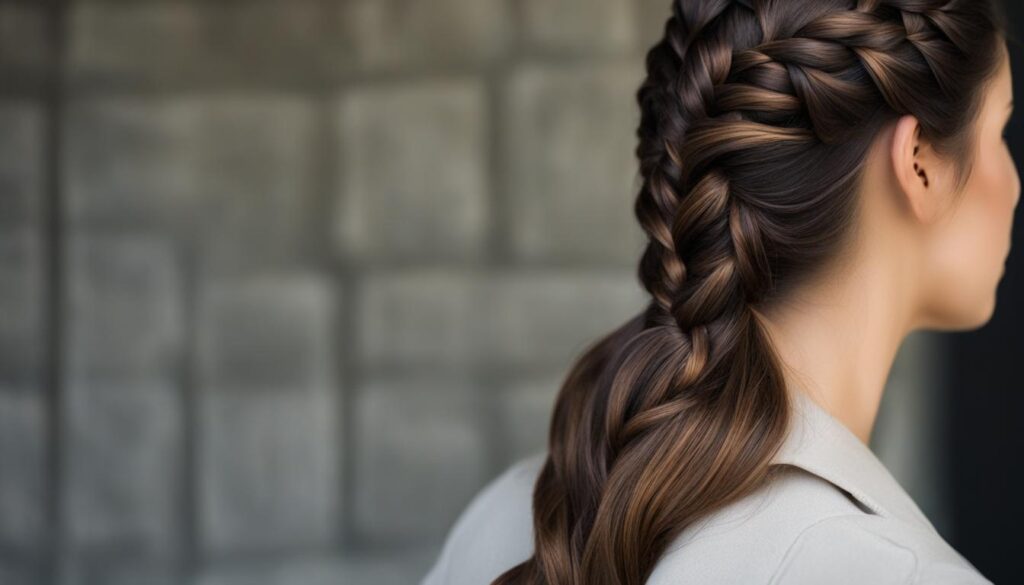
French braids have long been a popular hairstyle, but many adults wonder if they can pull off this look. In this article, I will explore the history and cultural significance of French braids, as well as provide insight into whether adults can confidently wear this versatile hairstyle.
Key Takeaways:
- French braids are not culturally offensive and can be worn by adults.
- French braids have origins in various cultures, including Africa, Greece, China, and the West.
- The name “French braid” originated from a short story published in Arthur’s Home Magazine.
- Cultural sensitivity is important when considering different hairstyles, such as cornrows.
- French braids offer a timeless and ageless look that can be styled in various ways.
The Origin of French Braids
French braids, with their intricate and elegant designs, have a long and fascinating history. While the exact origin of French braids remains unclear, they are believed to have been influenced by three different cultures: African, Greek, and Chinese.
One of the earliest evidence of braided hairstyles can be traced back to Africa, where people have been braiding their hair for thousands of years. Rock art found in North Africa depicts individuals with intricately braided hair, suggesting that the technique was well-established in ancient African cultures.
Greek statues from as early as the 6th century BCE also portray individuals with braided hair, showcasing the Greek influence on this hairstyle. The braids in ancient Greek culture were often adorned with ribbons or jewelry, symbolizing beauty and social status.
Another intriguing possibility is that the French braid may have originated from the women of the Song Dynasty in China. The women of this period were known for their elaborate hairstyles, which often included braids. This suggests that the technique of French braiding may have been introduced to Europe through trade and cultural exchanges.
The Influence of Culture on Hairstyles
The history of hairstyles is a testament to the rich tapestry of cultural influences that shape our perception of beauty. French braids, with their global origins, are a beautiful example of how cultures can blend and inspire each other to create timeless and versatile hairstyles.
It is important to embrace and appreciate the diverse origins of hairstyles while being mindful of cultural sensitivity. By understanding the history behind French braids and other hairstyles, we can wear them with respect and admiration for the cultures that have contributed to their creation.
| Culture | Influence on French Braids |
|---|---|
| African | Early evidence of braided hairstyles |
| Greek | Braided hairstyles depicted in ancient Greek art |
| Chinese | Possibility of introducing French braids through the Song Dynasty |
Why Is it Called French Braid?
Despite its name, the French braid has nothing to do with France. The hairstyle gained its name from a short story published in Arthur’s Home Magazine in 1871, where a husband referred to his wife’s hair as a “French braid.” The association of elegance and sophistication with France likely led to the name “French braid.”
“Her hair, so fair, so wavy, and so charmingly arranged in a French braid, made me yearn to caress it.”
The story, titled “A French Wife,” romanticized the image of a French woman with beautiful braided hair. It captured the imagination of readers and popularized the term “French braid” in English-speaking countries. However, it’s important to note that the hairstyle existed before the publication of this story, and its origins are believed to be rooted in various cultures.
The French braid is a versatile and timeless hairstyle that can be worn by anyone, regardless of their cultural background. It has evolved and become a popular choice for adults looking for an elegant and chic look. While the name may be misleading, the French braid remains a classic hairstyle that can be enjoyed by individuals of all ages.

French Braid vs. Dutch Braid
It’s worth mentioning that there is a slight difference between a French braid and a Dutch braid. While both hairstyles involve weaving strands of hair, the French braid starts at the crown of the head and incorporates new sections of hair as it progresses down. On the other hand, the Dutch braid starts at the nape of the neck and includes sections of hair from underneath, giving it a more raised appearance.
| French Braid | Dutch Braid |
|---|---|
| Starts at the crown of the head | Starts at the nape of the neck |
| Incorporates new sections of hair on top | Includes sections of hair from underneath |
| Tends to lie flat against the head | Has a raised appearance |
Both the French braid and the Dutch braid offer a stylish and sophisticated look. The choice between the two largely depends on personal preference and the desired outcome. Regardless of which style you choose, braided hairstyles can be a beautiful and versatile option for adults seeking a fashionable and timeless look.
Cultural Appropriation and French Braids
In today’s multicultural society, it is important to have conversations about cultural appropriation and understand the impact it can have on marginalized communities. When it comes to hairstyles, braids have a long history that is deeply rooted in African culture. However, the French braid, unlike cornrows, does not have direct ties to a specific culture or community. It is a versatile and widely worn hairstyle that has evolved and been adopted by people of various backgrounds.
Cultural appropriation occurs when someone from one culture adopts elements of another culture without understanding or respecting their historical and cultural significance. While French braids may not be inherently culturally appropriative, it is crucial to approach their styling with cultural sensitivity. This means acknowledging and appreciating the origins and meaning behind different hairstyles, including cornrows, and avoiding using them in ways that trivialize or devalue their cultural significance.
“Cultural appropriation occurs when elements of a minority culture are taken by members of a dominant culture, often without understanding or respect for the cultural context,” explains Dr. Kimberly Ellis, a cultural critic and educator specializing in race and gender studies.
“It is important to recognize that cultural appropriation is not about policing hairstyles or fashion choices. It is about acknowledging the power dynamics at play and being mindful of the ways in which historically marginalized cultures have contributed to trends and styles we may find aesthetically pleasing,” adds Dr. Ellis.
Ultimately, the key to avoiding cultural appropriation when it comes to hairstyles like French braids is to educate ourselves, show respect for the cultural origins of different styles, and celebrate the diversity of hairstyles in a way that honors their significance. By doing so, we can promote cultural exchange and appreciation while fostering a more inclusive and respectful society.
| H3: Cultural Appropriation and French Braids | H3: Cultural Sensitivity and Hairstyling |
|---|---|
| Cultural appropriation occurs when elements of a minority culture are taken by members of a dominant culture without understanding or respect for the cultural context. | Cultural sensitivity in hairstyling involves recognizing and understanding the historical and cultural significance of different hairstyles. |
| French braids, unlike cornrows, do not have direct ties to a specific culture or community and are widely worn by people of various backgrounds. | Showcasing hairstyles with cultural significance, such as cornrows, in a manner that trivializes or devalues their cultural roots can be culturally appropriative. |
| Respecting the origins and meaning behind different hairstyles and avoiding the exploitation of cultural practices is essential for fostering a more inclusive and respectful society. | Educating ourselves about diverse hairstyles and celebrating their cultural diversity can promote cultural exchange and appreciation. |
Conclusion
French braids are a versatile and timeless hairstyle that can be worn by adults. They are not limited to a specific culture and are generally accepted as a fashionable choice for people of all ages. Whether you’re looking for an elegant and polished look or a more casual and relaxed style, French braids can be tailored to suit your preferences.
One of the great things about French braids is their adaptability. They can be worn in different ways, such as loose and romantic or messy and bohemian. This makes them a favorite choice for those seeking ageless hairstyles that can be customized to suit any occasion.
While it’s important to appreciate the cultural significance of different hairstyles, French braids do not fall into the category of cultural appropriation. Unlike hairstyles like cornrows that have a complex history deeply rooted in African culture, French braids have origins in various cultures and are not exclusive to one group. However, it’s still crucial to be aware of and respect the historical context of different hairstyles.
In conclusion, French braids are a fantastic option for adults looking for stylish and adult-friendly hairstyles. They offer a timeless appeal and can be customized to reflect your personal style. By understanding the history and significance of different hairstyles, we can confidently embrace French braids as a chic and ageless look.
FAQ
Can adults wear French braids?
Yes, French braids are generally acceptable for adults to wear as they are not specific to a single cultural minority group.
What is the origin of French braids?
The exact origin is unclear, but they are speculated to have influences from various cultures, including northern Africa, Greece, and China.
Why is it called a French braid?
The hairstyle gained its name from a short story published in Arthur’s Home Magazine in 1871, where a husband referred to his wife’s hair as a “French braid.”
What is the difference between cultural appropriation and cultural appreciation when it comes to hairstyles?
Cultural appropriation occurs when someone from one culture exploits a practice or item from another culture without acknowledging its roots. Cultural appreciation, on the other hand, involves understanding and respecting the cultural significance of different hairstyles.
Can French braids be considered age-appropriate for adults?
Yes, French braids are a versatile and timeless hairstyle that can be worn by adults of all ages.






